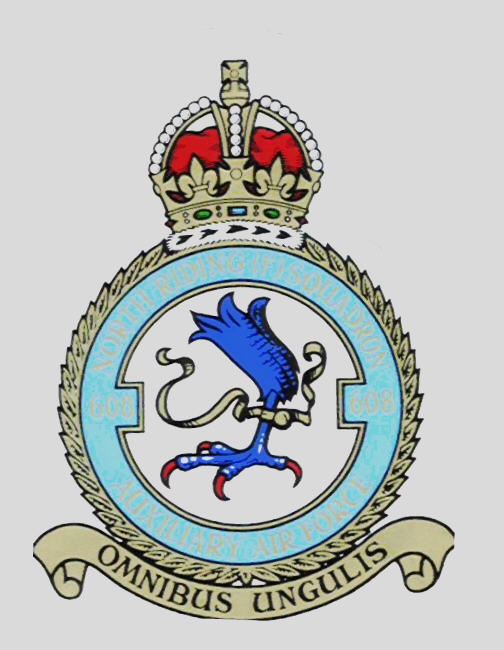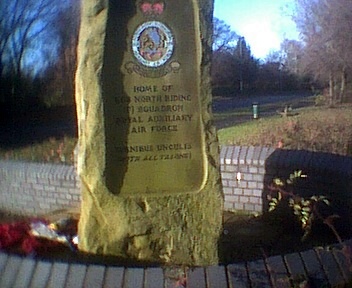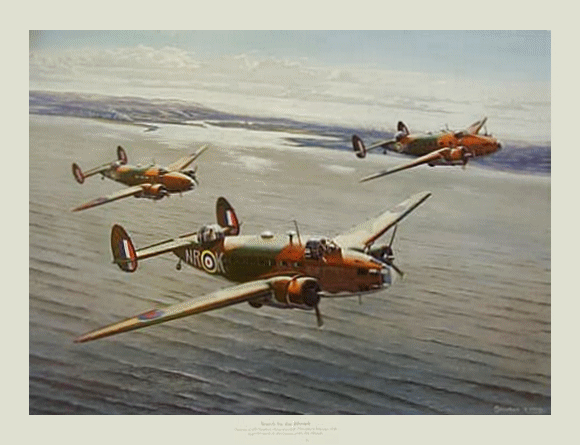The first known flying took place in 1912 from Vale Farm with a flying display sponsored by the Daily Mail.
The Royal Flying Corps. flew planes from Vale Farm during W.W.1.
In the 1920 's the Air Ministry purchased Thornaby Hall, Thornaby Grange,Thornaby Lodge and Vale Farms to convert to an airfield
The 608(North Riding) Auxiliary Air Force light bomber squadron was formed on 17 th. March 1930.The first regular R.A.F. unit to stay at Thornaby was 9FTS.with Hawker Hart Trainers which arrived during March 1937.


608 Sdn. converted to a fighter sdn. on 14 th. Jan 1937.
At the outbreak of WW2 Thornaby was to be used as a main bomber airfield.
By 3rd. Sept. 1939 the airfield went from one corrugated airplane shed and a grass field to a substantial complex of concrete runways and hangars to accomodate the thousands of airmen who would soon be using the site.
Spitfires and Blenheims were on hand to protect Coastal Command aircraft and the Aerodrome from intruders.
The Aerodrome was bombed a number of times during the war.
Search for the Altmark
On 6th August 1939 the German supply ship Altmark slipped through the English Channel and moved down to the South Atlantic. For the next 3 months she supplied the German battleship Admiral Graf Spee with oil and provisions thus allowing it to continue its forays against merchant shipping. The Altmark also became a prison ship, taking aboard survivors from ships attacked by the Graf Spee. On 13th December 1939 the Graf Spee was found and attacked by the cruisers HMS Exeter, HMS Ajax and HMS Achilles but entered the neutral port of Montivideo to avoid destruction. Altmark remained in the South Atlantic, hove to for some while with engine trouble, and then having completed repairs started the journey back to Hamburg. Keeping clear of all shipping, and with more than a little luck, she eventually crept round Iceland and reached Norwegian waters on 12th February 1940.At midnight on 13th February 1940 six of His Majesty's Ships, the cruiser HMS Arethusa, and the destroyers HMS Cossack, HMS Sikh, HMS Nubian, HMS Ivanhoe, and HMS Intrepid, sailed from Rosyth to search the waters off the Norwegian coast. The Altmark was hugging the Norwegian coast, staying in neutral waters. Despite being "inspected", but not searched, by Norwegian patrol vessels she continued slowly on her way. Just north of Bergen she was stopped again by the Norwegian destroyer Garm but the Captain of Altmark refused to allow a search and was told to leave the area.
The British ships were scattered over a wide area, Captain Vian and HMS Cossack were far to the south investigating the large number of ships in the Leads and among the offshore islands.
It was at that time that Royal Air Force planes from Thornaby took a hand in the proceedings.

On 16th of February, at 08.25 hours, a flight of Lockhead Hudson aircraft, led by 'K' and crewed by Pilot Officer McNeil and Pilot Lawrie, L.A.C. Sheekey and Cpl.Hugill were to find the Altmark, identify her, take photographs, and pass information of Altmarks position and direction as soon as possible, but not to attack. Pilot Officer McNeill has heard a signal from 'F' aircraft, telling of a vessel heading South, having been seen 15 miles north of the course of his flight and at 12.55 hours on seeing a dark shape ahead he made a wide sweep to view her from broadside. After this he then flew under the bows of the ship, where clearly painted was the name 'Altmark'. realising that unless intercepted very quickly the ship would make her escape, he instructed (against wireless orders), Wireless Operator Sheekey to 'bash' a message out - 'Enemy first sighting'. He felt sure that anyone interested in the Altmark would understand and take action.
At 12.50 hours on 16th February 1940 a wireless message was received giving the position of a ship thought to be the Altmark which had been spotted by an aircraft of Coastal Command. With HMS Cossack too far south, Captain Vian ordered HM Ships Intrepid and Ivanhoe to intercept at full speed, covered by the cruiser HMS Arethusa. At 14.45 hours Arethusa reached Altmark and holding a parallel course, with the two destroyers also approaching, the Altmark was ordered to steer west (into international waters). HMS Intrepid ordered Altmark to heave to and fired a shot across her bows but with Norwegian patrol ships hampering the British ships, Altmark slipped into Jøssingfjord.
HMS Cossack arrived at dusk and, after a conference with the Norwegians, who insisted that the Altmark had been searched and nothing found amiss, reported by wireless to the Admiralty and awaited their reply. The First Lord of the Admiralty, Mr. Winston Churchill, ordered that Captain Vian was to offer the Norwegians assistance to escort the Altmark back to Bergen to be searched again. If that offer was refused, the Altmark was to be boarded.
At 22.00 hours Captain Vian took HMS Cossack into the fjord and then gave the Norwegians the gist of Mr. Churchill's message. They replied that they were unable to co-operate as their ships were too small to force their way through the ice! At 23.12 hours, HMS Cossack approached the Altmark and, despite evasive action and an attempt to ram, a boarding party of 3 officers and 30 ratings took her. Four Germans were killed and five wounded in the brisk action. HMS Cossack sailed out of Jøssingfjord at 23.55 hours with 299 merchant seamen who had been released and they were landed at Leith after a fast passage home.
Aircraft from Thornaby were;
Aircraft K - Pilot Officer McNeill, Pilot Officer Lawrie, LAC Sheekey, Cpl. Hugill.
Aircraft M - Pilot Officer Fleetswood, Pilot Officer Dacomb, A/C Taylor, A/C Hopkins.
Aircraft V - Flt/Lt Downton, F/O Thwaite, A/C Parfitt, LAC Wilson.
220 Squadron, Royal Air Force, came to Thornaby on 21st August 1939.
Reproduced from extracts of coastal command reports and information on Thornaby Town Council Web site.
Flying ceased on 1st. Oct. 1958 and the airfield was sold to the council on 23 rd. Feb. 1962 as the site of the new Thornaby Town Centre.